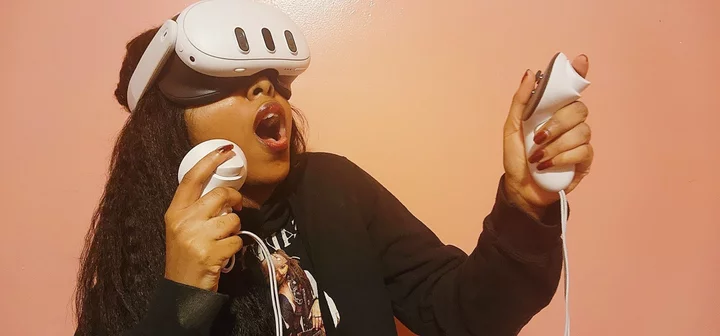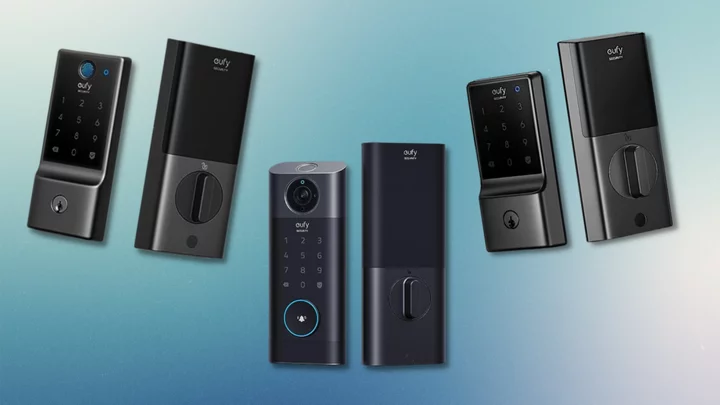“Take that!” I yelled. The Meta Quest 3, the successor to the Quest 2, had me ducking behind my chair and fighting fuzzy alien creatures who’ve crashed into my dining room.
The headset felt noticeably lighter and sleeker – even the controllers have a more ergonomic design as I fired my gun at the space invaders.
First Encounters Quest 3 game Credit: MetaThe Quest 3, unlike the Quest 2, can blend two realities simultaneously for mesmerizing augmented-reality (AR) experiences – hence why I was combating extraterrestrial enemies inside my humble abode. Conversely, the Quest 3’s predecessor is largely VR-only – you cannot not, for the most part, blend your real-world environment with simulated worlds.
While Meta fixed some Quest 2 flaws that drove me up the wall, there are still some lingering issues that remain on the Quest 3. As someone who has shed a tear or two after experiencing the Quest 2 for the first time in 2020 – yes, the immersion was that spellbinding – the Quest 3 hasn’t elicited the same feelings of enchantment and rapture out of me.
Something is missing. And we’re going to get to the bottom of it.
SEE ALSO: Meta Quest 3 hands-on impressionsMeta Quest 3 price and specs
The Quest 3 headset Meta sent to Mashable costs $499.99 and comes with the following specs:
Qualcomm Snapdragon XR2 Gen 2 chip
2,064 x 2,208-pixel resolution per eye
Immersive 3D audio
8GB of RAM
128GB of storage
Six camera sensors that power color mixed-reality as well as six-degrees-of-freedom tracking
If you upgrade to the 512GB variant, you'll have to shell out $649.99 for it. And no, there isn't a model with 256GB of storage.
At this point, you may be wondering, “Should I get the 512GB Meta Quest 3 or the 128GB variant?” To answer your question, I have the Meta Quest 2 64GB model, which is now discontinued. Over a span of three years, I have 40 games and apps in my library. Games in my portfolio range between 400MB and 4GB.
As such, 128GB of storage should be more than enough for the average consumer. However, if you have plans of becoming a VR influencer of sorts – perhaps you want to record gameplay for YouTube and Twitch followers – I’d highly recommend getting the 512GB model. Space runs out quickly if you’re storing hours upon hours of gameplay content.
You can pre-order the Quest 3 now, but it will ship on Oct. 10. You can purchase one here.
What I like about the Meta Quest 3
One of the annoying aspects of the Quest 2 headset is needing to regularly set up a Guardian. For the uninitiated, before hopping into any app on the Quest 2, you must trace your play area with your controller to “tell” your headset where your boundaries lie. This boundary typically sits between an empty space and some sort of obstacle (e.g., a wall, table, or chair). While you’re playing, if you’re getting too close to stepping beyond a boundary, a virtual barrier – or a Guardian – will appear to alert you.
In my personal experience, sometimes the Quest 2 “loses” the information of the Guardian you’ve set up, and you’ll have to retrace your play area again. The Quest 3, fortunately, changes all of that.
The Quest 3 automatically maps out your play area
When I saw that the Quest 3 automatically mapped out my play area, I was relieved. A glowing, virtual line perfectly traced my play area – leaving walls and tables out of the way – without me having to do a damn thing. Hallelujah!
Meta Quest 3 headset Credit: Kimberly Gedeon/MashableTrust me when I say that this was a major pain point of the Quest 3’s predecessor and I am elated that Meta rectified this issue with its new-generation VR headset.
Lens spacing adjustment is much better
There’s something called IPD adjustment on the Quest 2 headset, which lets you set the right lens spacing so that you can see visuals clearly in a way that’s uniquely comfortable to you. (If your IPD adjustment is off, the picture will appear blurry or out-of-focus. If it’s on point, however, the picture should be sharp and clear.) However, the Quest 2 only has three IPD presets, which means it's difficult to find that “sweet spot.” You also have to physically grab the lenses yourself and either move them apart or together to adjust the IPD.
Meta Quest 3 Credit: Kimberly Gedeon/MashableAdjusting IPD on the Quest 3 is much better. There is now a wheel on the VR headset, allowing you to fine-tune the IPD in a way that calibrates better with your eyes.
Color passthrough introduces new AR experiences
There’s a feature called passthrough on Quest devices that lets you see your surroundings while you’re still wearing the headset. On the Quest 2, passthrough is in grayscale – and the picture is too undefined and blurry. On the Quest 3, however, passthrough is in full color (thanks to two RGB cameras), which opens the floodgates to AR gaming experiences.
First Encounters Credit: MetaSome incredible AR-capable apps I've tested include Demeo, Cubism, Wooorld, Zombie Noir: Mixed Reality, and Waltz of the Wizard: Natural Magic. However, nothing beats First Encounters, a Quest 3 exclusive, which made it seem as if a gang of alien fuzzballs crash-landed into my home (the game I was alluding to in the intro).
The Quest 3's color passthrough is still too pixelated to be as immersive as I want it to be, but trust me, this is a major gen-over-gen leap from the Quest 3's black-and-white passthrough.
The controllers feel much nicer
The Quest 3’s controllers no longer have Quest 2’s funky-looking rings, and they feel more ergonomic than their predecessors.
Meta quest 3 controllers Credit: Kimberly Gedeon/MashableIt’s as if the controllers melt into every contour of my palms as they wrap around their stems.
It’s wireless
I was shocked to find out that one of my coworkers had no clue that the Meta Quest 2 and Quest 3 are wireless headsets. As such, I feel it’s necessary to make this clear. You do not need to hook up the Quest 3 to a PC. All you need to do is power it on, set up your WiFi, allow it to map your play area, and you’re off to the races.
However, you can plug it to a PC if you want to, which brings me to my next point.
You can access SteamVR games
Whether you get the Quest 3 or the Quest 2, you don’t have to stick to the apps and games in the Meta Quest Store. You can access VR games from Steam, too. However, in order to do this, you must have a PC with discrete graphics, a gaming laptop for example, so that you can harness its GPU power to run more intensive games, including Star Wars: Squadrons, Half-Life:Alyx, and The Elder Scrolls V: Skyrim. You’ll also need a USB-C to USB-C cable to connect your Quest 3 to a PC. Meta has one, but it costs $80.
Meta Quest 3 Credit: MetaThere are cheaper Amazon alternatives, including this one.
It’s also worth noting that, some time in the near future, Quest 3 users will have the opportunity to play games in their Xbox Game Pass library, too.
It's backwards compatible
If you already have a large portfolio of apps in your library, don't worry, you'll still have the opportunity to play them on the Quest 3. I, for example, continued playing one of my favorite Quest games – I Expect You to Die 3 – on the new-generation headset. I was saddened to see that I lost some progress from my Quest 2, but on the upside, I didn't have to start over from the very beginning either.
What I dislike about Meta Quest 3
There’s not much to dislike about the Quest 3. I don’t know any other headset on the market that delivers a wireless VR headset experience with access to a vast array of apps and games. However, there are some aspects of the Quest 2 that continue to plague the Quest 3.
The design could be better
Yes, the Quest 3 is much lighter than the Quest 2 like Meta claims – I’ll give ‘em that. However, while trying to figure out how to adjust the headset, I accidentally yanked the strap from its clasp. I’m sorry, but this doesn’t bode well for the headset’s durability. Plus, I never liked the straps’ white nylon and polyester material on the Quest 2 – and I still don’t like it on the Quest 3. It traps dirt like no other. It’s only a matter of time before your white straps turn off-white.
Meta Quest 3 Credit: MetaI also don’t like the new adjustment mechanism on the Quest 3. It just requires you to pull the dual straps away or towards each other, with the former making the headset more snug. However, I’m noticing that it’s difficult for it to remain tight exactly in the way that I want it – as if there’s something missing to keep it in place.
SEE ALSO: Meta Quest 2Fortunately, Meta sells an accessory called the Elite Strap that makes the headset a much better fit. Please, for the love of all things holy, get yourself the Elite Strap because it's much better than the out-of-the-box straps. It lets you tighten the headset with a dial and it’s much more comfortable. I use my Quest 2 with an Elite Strap and I wouldn’t use it any other way.
And Meta, can we get a black model? Please?!
What’s ‘eh’ about the Meta Quest 3
Now, let’s dive into the aspects of the Meta Quest 3 that neither excite me nor disappoint me.
The picture quality is OK
The Quest 3 features a Qualcomm Snapdragon XR2 Gen 2 chip – an upgrade from the quest 2’s Snapdragon XR 2 processor. Meta also boasts that the dual panels are "4K+ Infinite Displays," which deliver a 30% leap in resolution. At first glance, I didn’t immediately notice a significant picture-quality enhancement on the Quest 3. Games and apps are still far from having that high-fidelity look.
Left: Mothergunship Forge on Oculus Quest 3 Credit: Kimberly Gedeon/Mashable Right: Mothergunship Forge on Oculus Quest 2 Credit: Kimberly Gedeon/MashableHowever, when I put on my Quest 2 headset and ran Mothergunship Forge – and played the same game on the Quest 3 – I did spot a difference. Colors are richer on the Quest 3 and the picture quality is much sharper.
Hand tracking could be better
Keep in mind that hand-tracking is not exclusive to the Meta Quest 3; the Quest 2 uses hand-tracking, too. However, I find that “activating” hand-tracking mode is awkward.
Via GiphyIt only appears to work when I put my controllers down on the table, but even then, sometimes the Quest 3 fails to recognize that I want to use my hands. But when the headset does recognize my hand gestures, it works extremely well for navigating the UI. I can move the floating menu around the virtual space by grabbing and dragging it. I can pinch my fingers together to make selections, too.
But it gets hairy when I try using hand-tracking while gaming. For example, in Waltz of the Wizard: Natural Magic, I couldn’t seem to grab ingredients to put into my cauldron without dropping or breaking them. As such, hand-tracking is hit or miss on the Quest 3.
We need more AR games
Now that Quest 3 can incorporate your real-life surroundings into your headset for mixed-reality experiences, Meta needs to have a more robust library that reflects this. Why not give Beat Saber a passthrough update, allowing me to slice musical cubes with glow sticks in the middle of my own living room?
I got to try a few games that support mixed-reality, including Cubism, which lets you solve tetris-like puzzles in your real-world play area. However, I want more.
Cubism Quest 3 game in mixed-reality Credit: Kimberly Gedeon/MashableOn the plus side, Meta promises that over 100 new and upgraded apps are coming to the Quest 3 by the end of this year.
Meta Quest 3 battery life
Unfortunately, you’re not going to get a lot of play time out of the Quest 3. I started playing with the Quest 3 at around 3:56 p.m. on a Sunday. Without pausing for a break, it ran out of juice by 5:15 p.m. The Meta Quest 3 lasted one hour and 19 minutes on a single charge.
Final thoughts
The Quest 3 is, in many ways, better than the Quest 2. You no longer need to worry about mapping your own play area – the Quest 3 will do it for you. With the new-generation headset, you’re also opening yourself up to new mixed-reality experiences (though the Meta Quest store is scant on them).
I’m still not a fan of the Quest 3’s design, but that can be rectified with the aforementioned Elite Strap. Battery life isn’t all that great, but I can’t get myself to feel upset about it. After all, playing games with two snazzy displays directly in front of your eyes for hours on end can’t be good for your vision in the long run.
However, as I said in the outset, that “wow” factor I felt with the Quest 2 is missing on the Quest 3 – perhaps it's the so-so hand-tracking that's got me feeling slightly disillusioned. It’s too unreliable to use it regularly, but if Meta engineered it to be more stable, the Quest 3 would be one kickass VR headset.
Opens in a new window Credit: Kimberly Gedeon/Mashable Meta Quest 3 $499 Get Deal








